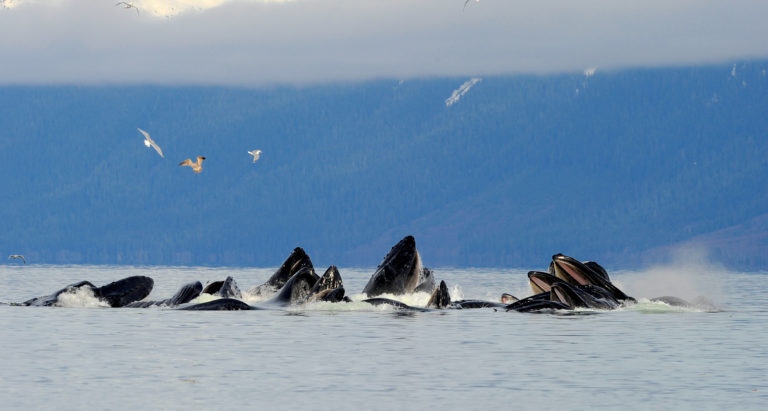B.C. researchers uncover mechanism that keeps large whales from drowning while feeding on krill
 A group of humpback whales in Alaska, near Sitka. (UBC handout photo/Ari Friedlaender)
A group of humpback whales in Alaska, near Sitka. (UBC handout photo/Ari Friedlaender)
New research from the University of British Columbia is shedding light on the ways that whales feed underwater without flooding their airways with seawater.
The research, published this month in Current Biology, shows that lunge-feeding whales – the type that lunge and gulp at large schools of krill – have a special mechanism in the back of their mouths that stops water from entering their lungs when eating.
“It’s kind of like when a human’s uvula moves backwards to block our nasal passages, and our windpipe closes up while swallowing food,” says lead author Dr. Kelsey Gil, a postdoctoral researcher in the department of zoology, in a statement.
Specifically, a fleshy bulb acts as a plug, to close off upper airways, while a larynx closes to block lower airways.
The humpback whale and the blue whale are both lunge-feeders, but the scientists’ research focused on fin whales, thanks in part to being able to travel to Iceland in 2018 and examine carcass remains at a commercial whaling station.
“We haven’t seen this protective mechanism in any other animals, or in the literature. A lot of our knowledge about whales and dolphins comes from toothed whales, which have completely separated respiratory tracts, so similar assumptions have been made about lunge-feeding whales,” Gil said.
Lunge-feeders are impressive, Gil said, because sometimes the amount of food and water they consume is larger than their bodies. After snapping at krill, and while blocking the water from their airways, the whales then drain the ocean water through their baleen, leaving behind the tasty fish.
The study’s senior author Dr. Robert Shadwick, a professor in the UBC department of zoology, says the efficiency of the whales’ feeding is a key factor in their evolution.
“Bulk filter-feeding on krill swarms is highly efficient and the only way to provide the massive amount of energy needed to support such a large body size. This would not be possible without the special anatomical features we have described,” he said in a statement.
CTVNews.ca Top Stories
Here's where Canadians are living abroad: report
A recent report sheds light on Canadians living abroad--estimated at around four million people in 2016—and the public policies that impact them.
What is a 'halal mortgage'? Does it make housing more accessible?
The 2024 federal budget announced on April 16 included plans to introduce “halal mortgages” as a way to increase access to home ownership.
'We are declaring our readiness': No decision made yet as Poland declares it's ready to host nuclear weapons
Polish President Andrzej Duda says while no decision has been made around whether Poland will host nuclear weapons as part of an expansion of the NATO alliance’s nuclear sharing program, his country is willing and prepared to do so.
Deadly six-vehicle crash on Highway 400 sparked by road rage incident
One person was killed in a six-vehicle crash on Highway 400 in Innisfil Friday evening.
Invasive and toxic hammerhead worms make themselves at home in Ontario
Ontario is now home to an invasive and toxic worm species that can grow up to three feet long and can be dangerous to small animals and pets.
Harvey Weinstein hospitalized after return to New York from upstate prison
Harvey Weinstein’s lawyer said Saturday that the onetime movie mogul has been hospitalized for a battery of tests after his return to New York City following an appeals court ruling nullifying his 2020 rape conviction.
Opinion I just don't get Taylor Swift
It's one thing to say you like Taylor Swift and her music, but don't blame CNN's AJ Willingham's when she says she just 'doesn't get' the global phenomenon.
Central Alberta queer groups react to request from Red Deer-South to reinstate Jennifer Johnson to UCP caucus
A number of LGBQT+2s groups in Central Alberta are pushing back against a request from the Red Deer South UCP constituency to reinstate MLA Jennifer Johnson into the UCP caucus.
Mookie Betts leads Dodgers past Blue Jays 4-2; Toronto drops fifth consecutive game
Mookie Betts went 3 for 5, including a triple and an RBI single, as the Los Angeles Dodgers beat the Toronto Blue Jays 4-2 on Saturday.

































